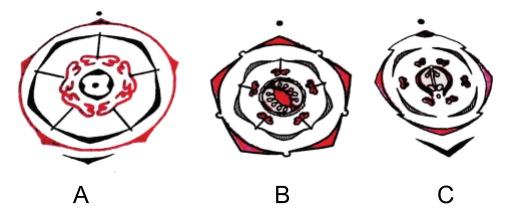
Three floral diagrams are given here. Their respective families are assigned in the answer key. Find out the families to which these diagrams belong to.

(a) A - Liliaceae, B - Asteraceae, C - Solanaceae
(b) A - Asteraceae, B - Solanaceae, C - Brassicaceae
(c) A - Asteraceae, B - Solanaceae, C - Asteraceae
(d) A - Poaceae, B - Solanaceae, C - Asteraceae

Answer
474.3k+ views
Hint: The first floral diagram belongs to the family that includes floral plants like garden marigold. Atropa belladonna is an example of the second family, while the third floral diagram represents the family which is commonly called the cabbage family.
Complete answer:
The diagram ‘A’ belongs to the family Asteraceae, ‘B’ belongs to Solanaceae and ‘C’ represents Brassicaceae.
Let's first learn about family Asteraceae.
-In the family Asteraceae, both the five sepals and five petals are arranged in valvate aestivation.
-There are a total of 5 stamens arranged in an epipetalous condition. This means that the stamens are fused with petals.
-The ovary in the family Asteraceae exhibits basal placentation.
Now let's study about family Solanaceae.
-The family Solanaceae exhibits 5 sepals that are united, persistent, and show valvate aestivation.
-The arrangement of petals is as follows: There are five petals, united and show valvate aestivation.
-There is a presence of 5 stamens in an epipetalous fashion i.e. stamens are fused with petals.
-The gynoecium is bicarpellary, obligately placed. The ovary is syncarpous, superior, and bilocular.
-The placenta is swollen with many ovules and shows axile placentation.
The features of the family Brassicaceae in brief are:
-The family Brassicaceae exhibits 4 sepals in two whorls with imbricate aestivation.
-The arrangement of petals is valvate aestivation.
-There are a total of six stamens arranged in two worlds in a tetradynamous condition. It is a condition where among the five stamens four stamens are long while two are short.
-The gynoecium is bicarpellary with the false separation between two locules.
So, the correct answer is, ‘A - Asteraceae, B - Solanaceae, C - Brassicaceae.’
Note: -The family Liliaceae exhibits 6 tepals often united into a tube showing valvate aestivation. There are a total of six stamens arranged in an epipetalous fashion. Here the gynoecium has tricarpellary, syncarpous ovary with axile placentation.
-In the family Poaceae that are usually three stamens. The gynoecium is monocarpellary with superior, unilocular ovule and axile placentation.
Complete answer:
The diagram ‘A’ belongs to the family Asteraceae, ‘B’ belongs to Solanaceae and ‘C’ represents Brassicaceae.
Let's first learn about family Asteraceae.
-In the family Asteraceae, both the five sepals and five petals are arranged in valvate aestivation.
-There are a total of 5 stamens arranged in an epipetalous condition. This means that the stamens are fused with petals.
-The ovary in the family Asteraceae exhibits basal placentation.
Now let's study about family Solanaceae.
-The family Solanaceae exhibits 5 sepals that are united, persistent, and show valvate aestivation.
-The arrangement of petals is as follows: There are five petals, united and show valvate aestivation.
-There is a presence of 5 stamens in an epipetalous fashion i.e. stamens are fused with petals.
-The gynoecium is bicarpellary, obligately placed. The ovary is syncarpous, superior, and bilocular.
-The placenta is swollen with many ovules and shows axile placentation.
The features of the family Brassicaceae in brief are:
-The family Brassicaceae exhibits 4 sepals in two whorls with imbricate aestivation.
-The arrangement of petals is valvate aestivation.
-There are a total of six stamens arranged in two worlds in a tetradynamous condition. It is a condition where among the five stamens four stamens are long while two are short.
-The gynoecium is bicarpellary with the false separation between two locules.
So, the correct answer is, ‘A - Asteraceae, B - Solanaceae, C - Brassicaceae.’
Note: -The family Liliaceae exhibits 6 tepals often united into a tube showing valvate aestivation. There are a total of six stamens arranged in an epipetalous fashion. Here the gynoecium has tricarpellary, syncarpous ovary with axile placentation.
-In the family Poaceae that are usually three stamens. The gynoecium is monocarpellary with superior, unilocular ovule and axile placentation.
Recently Updated Pages
Class 11 Question and Answer - Your Ultimate Solutions Guide

Master Class 11 English: Engaging Questions & Answers for Success

Master Class 11 Computer Science: Engaging Questions & Answers for Success

Master Class 11 Maths: Engaging Questions & Answers for Success

Master Class 11 Social Science: Engaging Questions & Answers for Success

Master Class 11 Economics: Engaging Questions & Answers for Success

Trending doubts
10 examples of friction in our daily life

What problem did Carter face when he reached the mummy class 11 english CBSE

Difference Between Prokaryotic Cells and Eukaryotic Cells

State and prove Bernoullis theorem class 11 physics CBSE

Proton was discovered by A Thomson B Rutherford C Chadwick class 11 chemistry CBSE

Petromyzon belongs to class A Osteichthyes B Chondrichthyes class 11 biology CBSE




